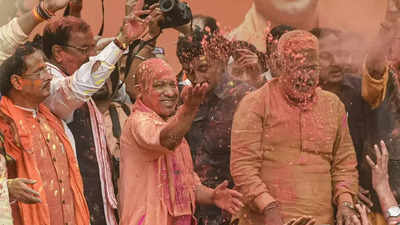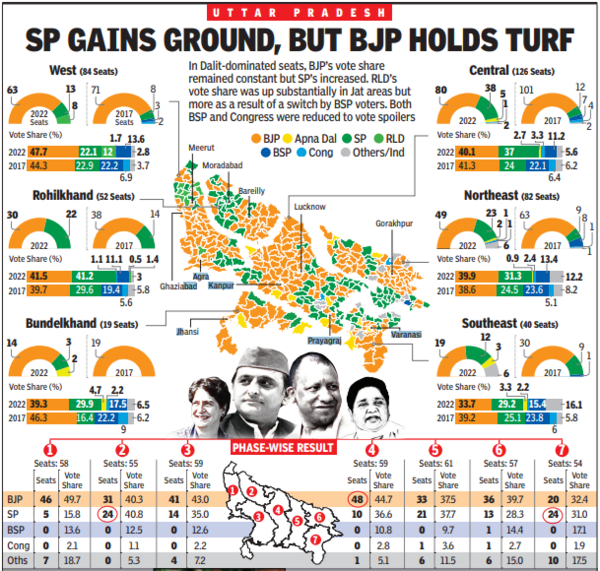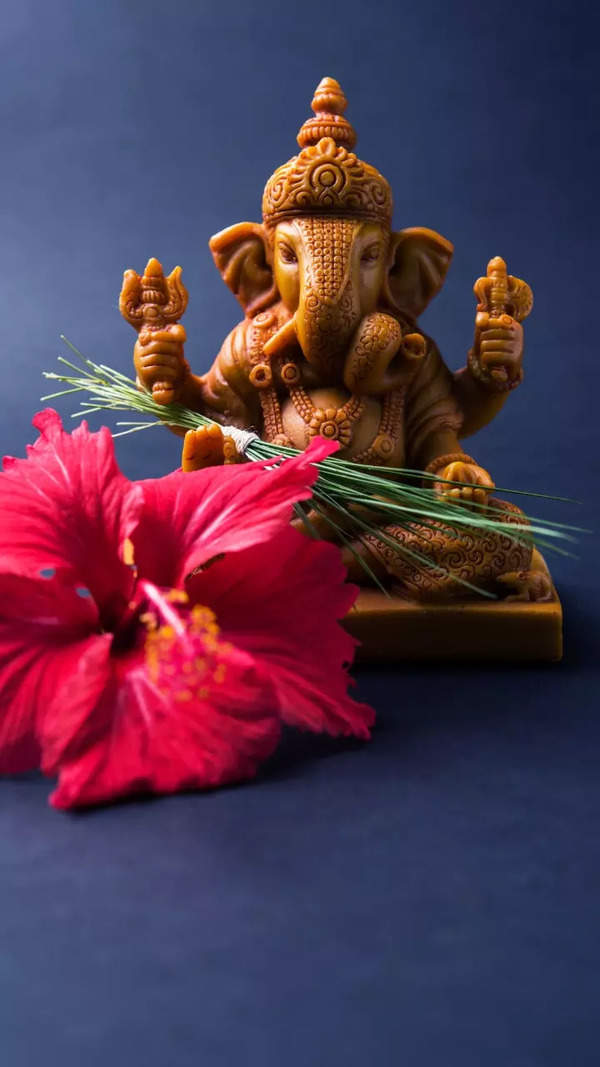- News
- India News
- UP assembly elections: BJP vote share rises, so does SP’s but Akhilesh cycle can’t keep up
Trending
This story is from March 11, 2022
UP assembly elections: BJP vote share rises, so does SP’s but Akhilesh cycle can’t keep up

UP chief minister Yogi Adityanath waves at the supporters after his victory in UP Assembly polls during a celebration at the party office, in Lucknow.
LUCKNOW: Even the best-ever show by the Samajwadi Party in its history in terms of vote share failed to get it to the magic figure of 203 seats in Uttar Pradesh. BJP not only held on to its 39% vote share in 2017, but also added nearly 2%.
Though the saffron camp lost 50-odd seats, it won enough to give it a two-thirds majority.
BSP took a big hit as its vote share sank to 12% from 22% in 2017. In terms of seats, it plunged from 19 to 1. The grand old party, Congress, which had fielded over 40% women candidates, saw even more erosion in its support base. It hit near rock-bottom with 2.3% vote share, down from 6.3% in 2017. It won two seats against seven the last time.
In terms of seats, it plunged from 19 to 1. The grand old party, Congress, which had fielded over 40% women candidates, saw even more erosion in its support base. It hit near rock-bottom with 2.3% vote share, down from 6.3% in 2017. It won two seats against seven the last time.

The tactic paid off as SP’s tally saw a jump of 69 seats from 47, which they won after alliance with Congress. By the time this report was filed, SP along with its alliance with RLD, Suheldev Bharatiya Samaj Party (SBSP), Apna Dal (Kamerawadi) and NCP was leading on 124 seats.
BJP’s tally dropped by 50-odd seats by the time this report was filed, but its vote share saw a rise by nearly 2%. The party forged an alliance with Apna Dal (S), Nishad to counter SP influence in the eastern parts. The party managed a vote share of 41.4% against the previous 39.7%, with Apna Dal (S) pitching in with 1.4%.
Though the saffron camp lost 50-odd seats, it won enough to give it a two-thirds majority.
BSP took a big hit as its vote share sank to 12% from 22% in 2017.


Thanks to a never-before consolidation of Muslims and Yadavs in favour of SP, and Akhilesh Yadav’s attempt to expand its caste bouquet, the charged-up party mopped up 31.9% vote share on its own. This was 10% more than its share in 2017 and nearly 3% more than its best vote share in 2012, which had given it 224 seats and a five-year stint. Taking lessons from previous elections, which saw a drop in its vote share in 2017, SP opted to break the caste equation that has been giving formidable victories to BJP. It formed alliances with smaller parties, representing Rajbhars, Kurmis, Mauryas, Dalits and Jats.
The tactic paid off as SP’s tally saw a jump of 69 seats from 47, which they won after alliance with Congress. By the time this report was filed, SP along with its alliance with RLD, Suheldev Bharatiya Samaj Party (SBSP), Apna Dal (Kamerawadi) and NCP was leading on 124 seats.
BJP’s tally dropped by 50-odd seats by the time this report was filed, but its vote share saw a rise by nearly 2%. The party forged an alliance with Apna Dal (S), Nishad to counter SP influence in the eastern parts. The party managed a vote share of 41.4% against the previous 39.7%, with Apna Dal (S) pitching in with 1.4%.
End of Article
FOLLOW US ON SOCIAL MEDIA










